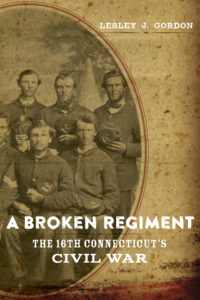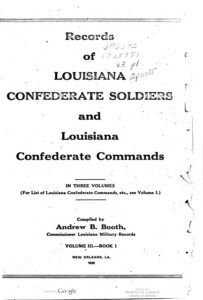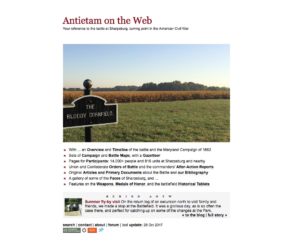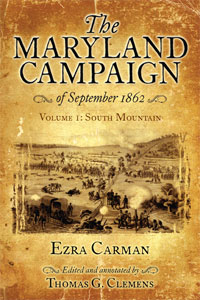Sgt Charles Broomhall at Antietam
14 April 2024
Almost exactly 20 years ago Carolyn Ivanoff shared with me (and AotW) her research about and transcription of the wartime diary of Charles D. M. Broomhall, Sergeant in the 124th Pennsylvania Infantry, describing his experience on the Maryland Campaign.
On my visit to the battlefield last Friday morning I saw this wayside for the first time. Maybe I just never stopped at that spot before.
I was stunned to see the heading quote from Sergeant Broomhall, from Carolyn’s work in the diary. That “fluttering” reference comes from a few lines earlier in his narrative:
At the commencement of the battle at day dawn [on 17 September 1862], our boys had been listening to the stray shots on the edge of the 1st named woods called the East Woods, the rebels had come through the corn and deployed pickets on the edge of the East Woods. Our pickets were deployed in the edge of this woods, consequently, at daylight the two picket lines found themselves face to face and that caused the suddenness of the onset. Our brigade was about 1/4 of a mile to the right and rear, and our regiment was brought up to near the clear sod field first spoken of while shot and shell went fluttering over our heads like partridges for sound.
Thanks again, Carolyn!
Dr. Lesley Gordon’s Roster, 16th Connecticut Infantry (2014)
6 February 2022
While researching her 2014 book about the regiment, Dr Lesley Gordon compiled a roster after my own heart, including pre- and post-war details not usually found in military records. She shared a spreadsheet containing her data on her book’s page. I’ve posted a copy here in the event that page ever goes away.
Here’s how she describes it:
This database of men who served in the regiment originated with the state of Connecticut’s Adjutant Generals Office Reports from 1862, 1869, and 1889. As I accumulated more (and sometimes conflicting) information, I filled in gaps and made corrections (especially birth and death dates, and postwar occupations) from the biographical materials collected [by] Ira Forbes and George Whitney … Death and birth dates seemed to have had the greatest inconsistencies in the various sources, and I tried to confirm these by cross-checking the U.S. census, bound regimental records, pension records, obituaries, local histories, as well as a comprehensive unit roster compiled by Scott Holmes. Thus, readers should be alerted that some discrepancies still remain here …
There may be discrepancies or minor issues, but it’s fantastic that she posted this online for anyone to use; it’s a rare and beautiful thing. Huzzah, Dr Gordon!
And I wish I’d found this earlier. It would have saved me untold hours with its clues to some of the more elusive men of the 16th at Antietam.
Huzzah! Hathi Trust
5 March 2021
My favorite basic source for Louisiana troops is Andrew Bradford Booth’s three volume set (in 7 books) of the Records of Louisiana Confederate Soldiers and Louisiana Confederate Commands (1920). A one-stop shop for the military basics on more than 102,000 individuals.
Until recently I’d consulted an online text transcription of Booth’s work, but it’s disappeared. A couple of days ago I found the Hathi Trust Digital Library has all 7 of the books, but had limited access to three of them for copyright issues.
Books published in the US before 1925 are now out of copyright – in the public domain – so I took advantage of the feedback form on the Hathi Trust site and pointed the problem out to them.
Amazing! Within an hour I had an acknowledgement and a few hours later Jessica from user support responded that she was passing my request to a copyright expert. The next day I got an email from Kristina saying she agreed the books are no longer under copyright and would open up access for US users. And she did, immediately. She also took the time to explain why they’d been restricted in the first place: there was a 1974 microfilming date on the copyright page.
This is in sharp contrast to the results I’ve had over the years from Google Books in many similar situations: Crickets. Nothing. Nada.
Bravo Hathi Trust!
Clickable, annotated Elliot burial map now on AotW
7 October 2020
In 1864, building on information collected by others, civil engineer Simon G. Elliott documented the locations of more than 5,800 soldiers’ burials on the battlefield of Antietam on a map. His similar work for burials at Gettysburg has long been known, but a copy of his Antietam map lay largely unnoticed in the New York Public library for many years until library staff digitized the map and made it available online between 2015 and 2018.
In June 2020 Gettysburg researchers Tim Smith and Andrew Dalton were looking into Elliott, came upon this map, and brought it to the attention of other historians and the public.
I’ve broken my digital copy into 14 large segments, each covering about 1/2 square mile of the battlefield, to make it a little easier for you to explore and make sense of this huge map. They’re all now up on Antietam on the Web (AotW) in a special exhibit.
49 individual soldiers and 32 regiments are identified on the big map. I have highlighted each of them in white and linked them to related pages on AotW so you can get more information about them.
This is Lieutenant Charles Frederick Williams, Jr. of the 35th Massachusetts Infantry. He was mortally wounded in action at Fox’s Gap on South Mountain on 14 September 1862 and died of wounds in Middletown, MD on 22 September.
His photo is from the Military Order of the Loyal Legion of the US, Massachusetts Commandery (MOLLUS-Mass) Civil War Photograph Collection, US Army Heritage and Education Center (USAHEC). The USAHEC, formerly the US Army Military History Institute (USAMHI) has hosted [gone in 2021] the excellent and massive MOLLUS Mass Collection online for at least 10 years (yay!), but they slapped this watermark over everything (boo).
Read more about the Collection history at Carlisle in a 2011 article by Molly Bompane.
____________________
update, 10 February 2021
Thanks to Heather Goyette in Ridgway Hall at USAHEC for the following instructions to find the MOLLUS images online:
The digital MOLLUS images … have been uploaded into our current Arena search page … You can then search … by entering the names of people, places, things, etc [in the search box]. As before, be sure to spell them out and not use abbreviations …
Clicking on the “Museum & Archives” tab near the top of the search results page will weed out library-related items …
To browse through individual album images enter “MOLLUS-Mass Civil War Photograph Collection” [in the search box] to see a listing of all digitized albums available, or enter something more specific such as “MOLLUS-Mass Civil War Photograph Collection Volume 4” to see what is available for an individual album. After selecting an album click on “Show linked records” to expand the list, and you can then click on individual image links to open them.
This new search interface will take some practice, but I’m so glad I can get the images again. And no sign of watermarks yet. Thanks USAHEC!
Below is Lt. Williams on page 4943 of Volume 96 of the Collection, with other officers of the regiment, from USAHEC.
Site Redesign Complete
20 February 2018
Antietam on the Web was a bit overdue for an overhaul: some of the PHP code had been deprecated (gone obsolete), much of the HTML was clumsy and likewise obsolete, and the site navigation didn’t make it easy to find the information on the site. Most of the navigation dated from 2005, and even the newest PHP and HTML code was last updated in 2010.
So I re-wrote and re-organized the whole thing.
The content is now gathered into big clusters for people (soldiers & units), places (maps), events (narrative), and features (special projects). I hope you’ll find it easier and more intuitive to use. It’ll certainly run more efficiently and be easier for me to maintain.
Here’s a quick visual comparison, new vs. previous home page design.
I’d love to hear how it works for you.
The Liljenquist photographs and Sharpsburg
31 December 2010
I have been busy with the business of life, but not entirely ignorant of the world outside! I certainly noticed the October 2010 announcement of the incredible generosity of the Liljenquist family who donated their collection of more than 700 Civil War ambrotypes and tintypes to the Library of Congress. The Library is creating a physical exhibit for them opening in April 2011 as part of the Sesquicentennial observations.
In the meantime, they’ve scanned and posted the collection online on their own pages and through a Flickr photostream. I’ve explored this treasure a little, and found some intriguing images with connections to our favorite battlefield.
![[Unidentified woman wearing mourning brooch and displaying framed image of unidentifed soldier] (LOC)](https://live.staticflickr.com/5201/5228622401_284617d66c.jpg)
Woman wearing mourning brooch and displaying framed image of soldier (1861 – 1865, Library of Congress via Flickr)
I’m sorry that so few of the subjects of these pictures are identified. Only a couple of dozen are named, another dozen or so are identified by military unit from clues on their uniforms or in the photo background. The remaining hundreds are unidentified.
I am moved all the more, however, by the anonymity of this woman in her grief. I presume from the context that the soldier in her lap has recently been killed. Her husband? It reminds me again of the deadly way the War ripped through families and brings perspective to battle maps, memorials and markers …
New blog: the Maryland Campaign of 1862
19 March 2010
Tom Clemens makes his debut in the blogosphere today on The Maryland Campaign of 1862. That’s also the title of his two-volume series coming soon from Savas-Beatie: a carefully annotated edition of General Ezra Carman’s life’s work.
Volume 1: South Mountain arrives mid-May 2010.
Among other things, Tom promises to use the site to get some of the hundreds of letters from battle veterans to Carman and the Antietam Battlefield Board online. Those eyewitness accounts formed much of the factual basis for Carman’s iconic narrative of the battle.
Tom’s new website/blog uses WordPress software, with a custom visual design built on the Thematic framework. I can recommend this software combination to anyone who wants to get online quickly, while still serving clean, fast-running and compliant code, with simple maintenance and vast flexibility in visual appearance.
In short, the tool doesn’t get in the way of the content.
WordPress makes it easy for Tom – who is not a web guy by profession – to maintain both the content and the look & feel of his online home down the road.
Good blogging and welcome, Tom!
Frank Schell’s battle
17 January 2010
Frank Schell accompanied the Army of the Potomac on the Maryland Campaign of 1862, and was on the field for the battle on 17 September. He was a civilian there from New York – a sketch artist for Frank Leslie’s Illustrated Newspaper.
Fortunately for those who study the battle, a number of his original battlefield sketches have survived. I’ve recently discovered a set sold at auction in 2007, and a group preserved in a collection at Boston College, in particular. I’ve grabbed some selected gems among them to use here.
Even better, in 1904 Schell published his recollection of the events that were going on around him as he was drawing these same pictures. So in sharing his pictures and his superb eye, I can also leave the writing to Frank – to narrate his own drawings and give us a sense of his Battle of Antietam.


Hooker’s Corps crosses the Antietam (16 September 1862, pub. Leslie’s 11 Oct 1862)
As I awoke soon after daylight on the morning of September 17, 1862, the air was already vibrating with mighty sounds of battle … With spirits aflame, I speeded at my best from Keedysville for the headquarters of the commanding general … I joined the group about the commanding general, who was anxiously scanning through his field glass the situation to the right, across the Antietam. Looking more to the left, the thick west wood, with its dark, broad front so clearly emphasized by the little white Dunker church, was clearly in view along its entire extent upon the Hagerstown turnpike.
General McClellan suddenly lowered his glass, and, with a few animated words and expressive gestures, called Porter’s attention to something that caused an immediate ferment of buzzing excitement throughout the group and a close scrutinizing of the bit of woodland, for the time being, the focus of such absorbing interest …
An excellent companion to Moore’s Roster for researching North Carolina troops is the 5 Volume Histories of the Several Regiments and Battalions from North Carolina in the Great War, 1861-1865, published by the State of North Carolina in 1901. Editor Walter Clark was Adjutant of the 35th Regiment at Sharpsburg, and later Lieutenant Colonel of the 70th Regiment.
All NC military units – along with an array of related subjects – are represented in one or more articles, and each piece is written by a veteran who served in the regiment, battalion, or battery. Their works range from brief essays to fairly sophisticated unit histories. As a bonus, most include selections of war-period photographs of officers and men. There are hundreds of faces altogether across the volumes.

These volumes are available online from both GoogleBooks and the Internet Archive (IA) Collection. I like the IA image quality and paging interface best, so a hyperlinked table of contents (hyperTOC) for that online edition follows …











